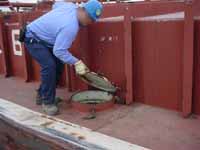Shipyard Employment eTool
Barge Cleaning Operations >> Chemical Cargo Barges
Chemical cargo barge cleaning is the process of removing residual cargo and cleaning the tanks on the barge in order to load a new or different cargo, inspect, or repair. Cleaning may be conducted on a barge while at a pier, in a drydock, while beached, or at anchor. The cleaning process normally includes:
Each of these steps include many of the same hazards. The most important hazards are to due flammable materials, and inhalation or skin contact from chemical exposures. It is important to address Hazard Communication [29 CFR 1915.1200], personal protective equipment [29 CFR 1915 Subpart I], and the exposure limits in 29 CFR 1915 Subpart Z. These hazards should be evaluated throughout the barge cleaning process.
- Acrylates (Ethyl and Butyl [29 CFR 1915.1000], Methyl)
- Acrylonitrile [29 CFR 1915.1045]
- Adiponitrile
- Aniline [29 CFR 1915.1000]
- Benzene [29 CFR 1915.1028]
- Caustic/Non-Caustic Lube Oils (such as #6 oil, lube oil, crude oil, and parafins)
- Chlorinated Solvents (Methylene Chloride [29 CFR 1915.1052], Chloroform [29 CFR 1915.1000])
- Gasoline [29 CFR 1915.1000]
- Gasoline Additives (Methyl Tert-Butyl Ether [MTBE], Reformate)
- Glycol and Glycol Ethers [29 CFR 1915.1000]
- Isopropanol [29 CFR 1915.1000]
- Methanol [29 CFR 1915.1000]
- Methyl Ethyl Ketone [29 CFR 1915.1000]
- Sulfuric Acid [29 CFR 1915.1000]
- Styrene [29 CFR 1915.1000]
- Toluene [29 CFR 1915.1000]
- Xylene [29 CFR 1915.1000]
Additional Resources:
- NIOSH Pocket Guide
- NFPA 306, Control of Gas Hazards on Vessels. National Fire Protection Association.
- 33 CFR, Subpart 154 - Facilities Transferring Oil or Hazardous Materials in Bulk. This regulation is available on-line through the GPO Access website.
- 154.735 - Safety Requirements. U.S. Coast Guard. This regulation allows for the incorporation of the International Safety Guide for Oil Tankers & Terminals (ISGOTT) guide for tank cleaning under 33 CFR 154.735(s)(1-3).
- OCIMF International Safety Guide for Oil Tankers & Terminals. International Chamber of Shipping (ICS). This document outlines the international standard for cleaning tanks.
- Safety Guidelines For Tank Vessel Cleaning Facilities. American Waterways Shipyard Conference. This guideline was created by the American Waterways Shipyard Conference (AWSC). AWSC merged with the Shipbuilders Council of America (SCA) in 1999.
Note: Confined space entry is one of the leading hazards associated with barge cleaning. Review the Ship Repair: Confined or Enclosed Spaces and Other Dangerous Atmospheres chapter for information on how to protect workers from this hazard.
Includes securing the barge, reviewing the structural plan of the vessel, preventing static discharge, connecting hoses, ballasting, and identifying hazardous materials.
The following safety and health information should be reviewed:
- Hazardous material assessment
- PPE Selection: Cleaning and Other Cold Work
- Access to barges and river towboats
See also, Access and Guarding of Working Surfaces - General working conditions
- Fire and explosion hazards
- Respiratory hazards
- Corrosive and toxic material hazards
- Excessive noise hazards
- Limited access hazards
- Slip and trip hazards
- Fall hazards
- Work environment temperature related hazards
- Electrical hazards

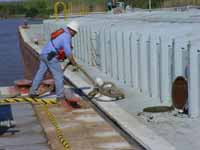

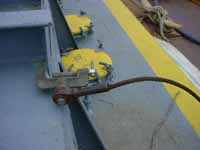
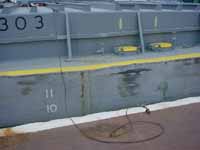

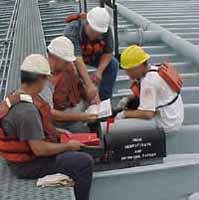
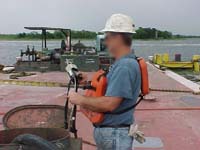
Includes setting up cleaning equipment, opening covers and manholes, and visually inspecting tanks from the outside.
The following safety and health information should be reviewed:
- Opening covers
- Ventilation
- Typical Health Hazards
- PPE Selection: Cleaning and Other Cold Work
- Access to barges and river towboats
See also, Access and Guarding of Working Surfaces - Ladders
- Tools and Related Equipment
- General working conditions
- Fire and explosion hazards
- Respiratory hazards
- Corrosive and toxic material hazards
- Excessive noise hazards
- Limited access hazards
- Slip and trip hazards
- Fall hazards
- Work environment temperature related hazards
- Electrical hazards
Additional Resources:
- 29 CFR 1918 Subpart E, Opening and Closing Hatches. Note: This reference is for informational purposes only and is not required in Shipyard Employment.
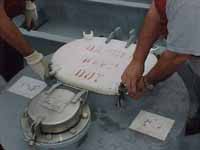


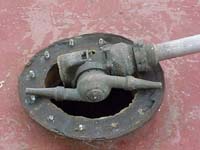

Includes the cleaning processes, such as tank washing, pumping of residues, ventilating for entry, entry procedures, hand-cleaning in tanks, and cleaning of piping and pumps.
The following safety and health information should be reviewed:
- Confined or Enclosed Spaces and Other Dangerous Atmospheres
- PPE Selection: Cleaning and Other Cold Work
- Access to barges and river towboats
See also, Access and Guarding of Working Surfaces - Ladders
- Tools and Related Equipment
- Materials Handling
- General working conditions
- Fire and explosion hazards
- Respiratory hazards
- Corrosive and toxic material hazards
- Excessive noise hazards
- Limited access hazards
- Slip and trip hazards
- Fall hazards
- Work environment temperature related hazards
- Electrical hazards

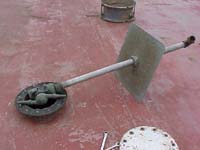
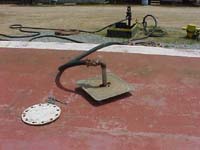
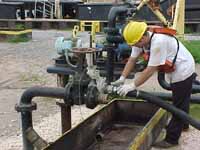


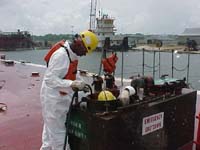

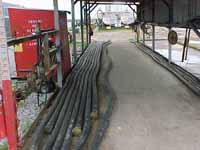
Includes obtaining gas free/product certifications if necessary, final inspection, equipment removal and closing up the barge (closing of butterworth and manhole lids).

The following safety and health information should be reviewed:
- Confined or Enclosed Spaces and Other Dangerous Atmospheres
- PPE Selection: Cleaning and Other Cold Work
- Access to barges and river towboats
See also, Access and Guarding of Working Surfaces - Ladders
- Tools and Related Equipment
- Materials Handling
- General working conditions
- Fire and explosion hazards
- Respiratory hazards
- Corrosive and toxic material hazards
- Excessive noise hazards
- Limited access hazards
- Slip and trip hazards
- Fall hazards
- Work environment temperature related hazards
- Electrical hazards
